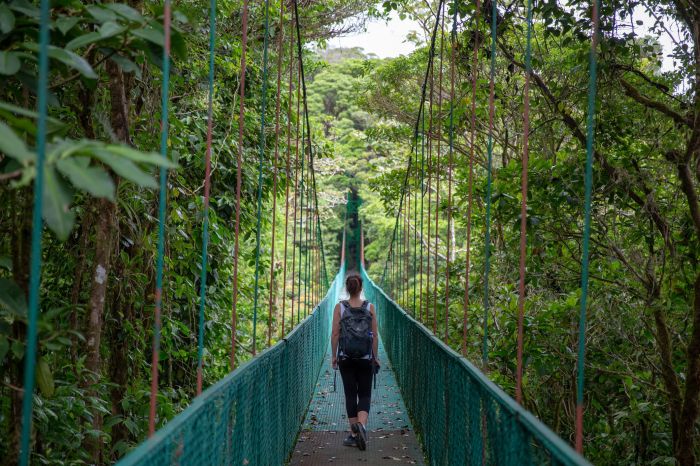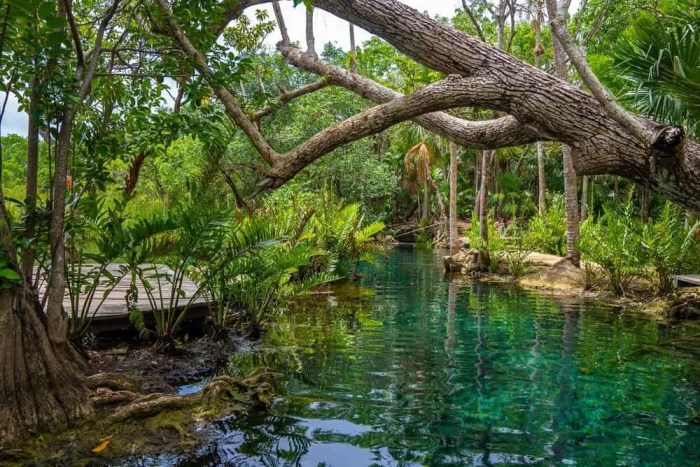Embark on a journey to sustainable travel destinations, where responsible tourism practices meet breathtaking natural wonders. As travelers become increasingly conscious of their environmental impact, exploring destinations that prioritize sustainability offers an opportunity to minimize our footprint while enriching our experiences.
From eco-friendly accommodations to responsible transportation options, this guide delves into the key elements of sustainable travel. Discover how you can embrace responsible tourism practices, protect natural and cultural heritage, and contribute to local communities while creating unforgettable memories.
Eco-Friendly Accommodations

As travelers become more environmentally conscious, the demand for sustainable accommodations is on the rise. Eco-friendly accommodations prioritize sustainability by using renewable energy, reducing waste, and supporting local communities. These accommodations offer travelers a way to minimize their environmental impact while still enjoying a comfortable and memorable vacation.
There are many different types of eco-friendly accommodations available, from small bed and breakfasts to large resorts. Some popular examples include:
- Treehouse Lodge in Costa Rica: This lodge is built entirely from sustainable materials and uses solar power to generate electricity. It also has a strict recycling program and offers guests the opportunity to participate in reforestation projects.
- Six Senses Yao Noi in Thailand: This resort is located on a private island and is committed to zero waste. It uses renewable energy sources, recycles and composts all waste, and has a water conservation program.
- Bardessono Hotel in California: This hotel is LEED Platinum certified and is one of the most sustainable hotels in the United States. It uses solar power, has a green roof, and offers guests organic and locally sourced food.
The benefits of choosing eco-friendly accommodations are numerous. For travelers, these accommodations offer a way to reduce their environmental impact and support sustainable tourism. For the environment, these accommodations help to protect natural resources and reduce pollution.
Sustainable Transportation Options

Sustainable transportation options minimize environmental impact and promote responsible travel. These include public transportation, electric vehicles, and bike rentals, which offer eco-friendly alternatives to traditional car rentals or private vehicles.
Environmental Impact of Transportation Modes
The environmental impact of different transportation modes varies significantly. Consider the following table:
| Transportation Mode | Carbon Emissions (grams/passenger-kilometer) |
|---|---|
| Air travel | 256 |
| Car (gasoline) | 150 |
| Train (electric) | 14 |
| Bus (diesel) | 10 |
| Bike | 0 |
Infrastructure and Policies for Sustainable Transportation
Popular travel destinations are investing in infrastructure and policies that support sustainable transportation. These include:
- Dedicated bus lanes and bike paths
- Electric vehicle charging stations
- Subsidies for public transportation and bike rentals
- Congestion pricing to discourage private vehicle use
Responsible Tourism Practices

As travelers, we have a responsibility to minimize our environmental impact and support the communities we visit. Responsible tourism practices help protect the environment, conserve resources, and promote cultural understanding.
Here are some tips for responsible tourism:
Reduce Waste
- Bring reusable water bottles, shopping bags, and containers.
- Avoid single-use plastics, such as straws, utensils, and bags.
- Recycle and compost whenever possible.
- Choose accommodations that have waste reduction programs.
Conserve Water and Energy
- Take shorter showers and turn off the water when brushing your teeth.
- Unplug electronics when not in use.
- Choose energy-efficient accommodations and transportation options.
- Support businesses that use renewable energy sources.
Respect Local Cultures and Ecosystems
- Learn about local customs and traditions before you travel.
- Be respectful of wildlife and their habitats.
- Avoid activities that harm the environment, such as littering or damaging coral reefs.
- Support businesses that promote local culture and conservation efforts.
Support Local Businesses and Communities, Sustainable travel destinations
- Stay in locally-owned accommodations.
- Eat at local restaurants.
- Buy souvenirs from local artisans.
- Participate in community-based tourism activities.
By adopting these responsible tourism practices, we can help protect the environment, conserve resources, and support local communities.
Destination Management Strategies

Destination management organizations (DMOs) play a pivotal role in fostering sustainable tourism practices. They collaborate with local stakeholders, including tourism businesses, government agencies, and community groups, to develop and implement sustainable tourism plans. These plans aim to minimize the negative impacts of tourism on the environment and local communities while maximizing its economic and social benefits.
Best Practices for Managing Tourism Impacts
Effective destination management strategies involve implementing best practices to mitigate the environmental and socio-cultural impacts of tourism. These practices include:
- Conducting environmental impact assessments to identify potential risks and develop mitigation measures.
- Establishing carrying capacities to limit the number of visitors to sensitive areas.
- Promoting responsible tourism practices among visitors, such as respecting local customs and minimizing waste.
- Investing in sustainable infrastructure, such as eco-friendly transportation and energy-efficient accommodations.
- Educating local communities about the importance of sustainable tourism and involving them in decision-making processes.
Stakeholder Collaboration and Community Involvement
Successful sustainable tourism planning requires collaboration among all stakeholders, including local businesses, residents, and government agencies. DMOs facilitate this collaboration by creating platforms for stakeholder engagement and ensuring that community voices are heard. By involving local communities in decision-making, DMOs can ensure that tourism development aligns with their needs and aspirations, fostering a sense of ownership and responsibility for sustainable practices.
Technology for Sustainable Travel: Sustainable Travel Destinations
Technology plays a vital role in promoting sustainable travel practices. It empowers travelers to make informed decisions, monitors tourism impacts, and enhances overall sustainability efforts.
Mobile apps and online platforms provide travelers with a wealth of information on eco-friendly accommodations, responsible tourism operators, and sustainable transportation options. These platforms offer real-time data, reviews, and recommendations, enabling travelers to choose options that align with their sustainability values.
Data Analytics for Monitoring and Management
Data analytics is a powerful tool for monitoring and managing tourism impacts. By collecting and analyzing data on visitor numbers, travel patterns, and resource consumption, destinations can identify areas for improvement and develop targeted strategies to mitigate negative impacts.
For those seeking to explore the world while minimizing their environmental impact, sustainable travel destinations offer an ethical and responsible way to travel. From eco-lodges nestled in lush rainforests to carbon-neutral cities, these destinations prioritize conservation and community involvement. While luxury travel often conjures images of opulent resorts and private jets, it’s worth exploring the top luxury travel destinations that embrace sustainability.
By combining eco-friendly practices with high-end amenities, these destinations allow travelers to indulge in luxury while making a positive impact on the planet.
For example, data analytics can be used to identify popular attractions that are experiencing overcrowding and implement measures to manage visitor flow. It can also help identify areas where waste generation is high and develop strategies to reduce waste production.
Certification and Standards

Sustainability certifications and standards provide travelers with a framework to identify destinations and accommodations that prioritize environmental conservation, social responsibility, and economic viability.
Sustainable travel destinations are becoming increasingly popular as travelers seek out ways to reduce their environmental impact while exploring the world. From eco-friendly hotels and resorts to national parks and wildlife sanctuaries, there are a growing number of sustainable travel destinations to choose from.
By choosing to visit these destinations, travelers can help support local communities, protect the environment, and create a more sustainable future for all.
These certifications are awarded by independent organizations that assess destinations and accommodations based on specific criteria and requirements. By choosing certified destinations and accommodations, travelers can support businesses that demonstrate a commitment to sustainability.
Certification Criteria
- Environmental stewardship: Conserving natural resources, reducing pollution, and protecting biodiversity.
- Social responsibility: Respecting local communities, supporting fair labor practices, and promoting cultural heritage.
- Economic viability: Ensuring long-term economic benefits for local businesses and communities.
- Health and safety: Maintaining high standards of hygiene, food safety, and employee well-being.
Benefits of Choosing Certified Destinations and Accommodations
For Travelers
- Peace of mind: Knowing that their travel choices align with their values.
- Authentic experiences: Engaging with destinations that showcase local culture and heritage while preserving the environment.
- Support for sustainable businesses: Contributing to the growth of businesses that prioritize environmental and social responsibility.
For the Industry
- Recognition for sustainability efforts: Certification can enhance the reputation and visibility of destinations and accommodations.
- Improved operations: Certification can help businesses identify areas for improvement and optimize their sustainability practices.
- Market differentiation: Certified destinations and accommodations can stand out in a competitive market.
Destination Case Studies

Sustainable tourism destinations serve as shining examples of how to balance tourism development with environmental protection and socio-cultural preservation. These case studies offer valuable insights into the challenges, successes, and innovative approaches employed in creating sustainable tourism destinations.
Costa Rica: A Pioneer in Ecotourism
Costa Rica has long been a leader in sustainable tourism, earning recognition for its conservation efforts and commitment to ecotourism. The country has established a comprehensive system of national parks and protected areas, covering over a quarter of its landmass. Tourism revenue has played a crucial role in funding these conservation initiatives, while also benefiting local communities through job creation and economic development.
One of Costa Rica’s most successful sustainable tourism initiatives is the Monteverde Cloud Forest Reserve. This private reserve was established in the 1970s to protect the unique cloud forest ecosystem and its biodiversity. The reserve has implemented a range of sustainable practices, including responsible trail management, visitor education, and community involvement. Tourism revenue has helped fund conservation efforts and support local communities, making the reserve a model for sustainable tourism development.
Iceland: Balancing Tourism and Conservation
Iceland has experienced a surge in tourism in recent years, posing challenges to the country’s pristine natural environment. In response, Iceland has implemented a range of measures to balance tourism development with conservation. These include strict regulations on tourism activities in sensitive areas, such as the popular Golden Circle route. The country has also invested in infrastructure to manage tourism impacts, such as hiking trails and visitor centers.
One example of Iceland’s commitment to sustainable tourism is the Vatnajökull National Park. This vast park encompasses glaciers, volcanoes, and other natural wonders. The park has implemented a comprehensive management plan to minimize tourism impacts, including zoning restrictions and visitor education programs. These measures have helped protect the park’s fragile ecosystem while still allowing visitors to experience its beauty.
When seeking sustainable travel destinations that cater to families, family-friendly resorts emerge as a prime choice. These resorts prioritize eco-friendly practices while offering a range of activities and amenities tailored to the needs of families, ensuring a memorable and responsible vacation experience.
By choosing sustainable travel destinations like these, families can contribute to the preservation of natural environments while creating lasting memories.
Future Trends in Sustainable Travel

The future of sustainable travel holds exciting prospects as emerging trends and innovations continue to shape the industry. Technological advancements, evolving consumer preferences, and proactive government policies are driving significant changes in the way we travel, creating both opportunities and challenges for destinations and travelers alike.
Technology for Sustainable Travel
Technology plays a pivotal role in promoting sustainable travel practices. Artificial intelligence (AI) and machine learning (ML) algorithms enable personalized recommendations for eco-friendly accommodations, transportation options, and activities, empowering travelers to make informed choices that minimize their environmental impact.
- AI-powered travel planning apps optimize itineraries, reducing unnecessary travel and carbon emissions.
- Real-time monitoring systems provide insights into destination capacity, preventing overcrowding and promoting responsible tourism.
- Virtual and augmented reality (VR/AR) technologies offer immersive experiences, reducing the need for physical travel.
Changing Consumer Preferences
Consumer preferences are shifting towards sustainable travel, driven by increased awareness of environmental issues and a desire for meaningful travel experiences. Travelers are seeking destinations and businesses that prioritize sustainability, supporting local communities, and preserving natural resources.
- Studies show a growing demand for eco-friendly accommodations and transportation options.
- Consumers are more likely to choose destinations that demonstrate a commitment to responsible tourism practices.
- Travelers are increasingly seeking immersive experiences that connect them with local cultures and environments.
Government Policies and Regulations
Government policies and regulations play a crucial role in shaping the future of sustainable travel. Governments are implementing measures to reduce carbon emissions from tourism, promote renewable energy sources, and protect biodiversity.
- Carbon taxes and emissions regulations encourage airlines and cruise lines to adopt more sustainable practices.
- Destination management plans incorporate sustainability goals and guidelines for responsible tourism development.
- Protected areas and national parks implement visitor management systems to preserve natural resources.
Closing Notes

Embracing sustainable travel destinations is not only a responsible choice but also a rewarding one. By choosing eco-friendly options and supporting local communities, we can create a positive impact on the destinations we visit while preserving their beauty and cultural integrity for generations to come.
FAQ Resource
What are the benefits of choosing eco-friendly accommodations?
Eco-friendly accommodations prioritize sustainability through practices such as using renewable energy, reducing waste, and supporting local communities. By choosing these accommodations, travelers can minimize their environmental impact while contributing to local economies.
How can I reduce my environmental footprint while traveling?
To reduce your environmental footprint while traveling, consider opting for sustainable transportation options like public transportation or electric vehicles, reducing waste by using reusable items and minimizing consumption, and conserving water and energy in your accommodation.
Why is it important to support local businesses and communities through tourism?
Supporting local businesses and communities through tourism helps distribute the benefits of tourism more equitably. It also helps preserve local cultures and traditions, create employment opportunities, and promote economic development in the destinations we visit.